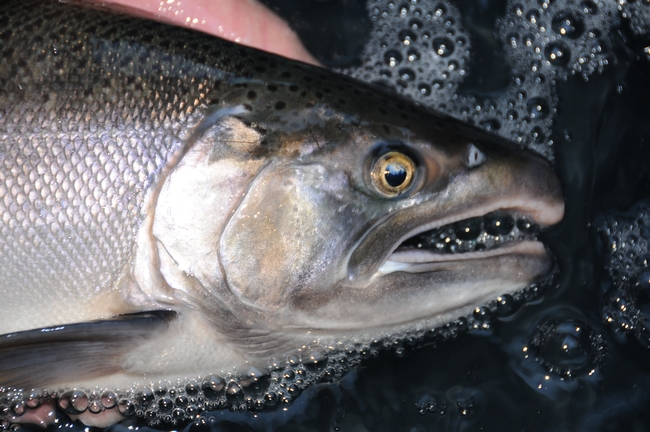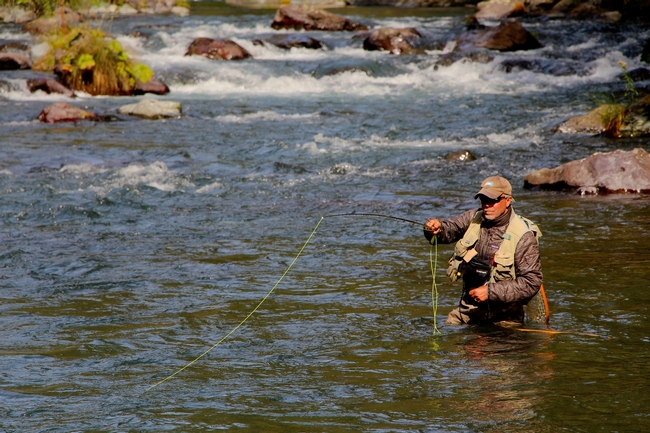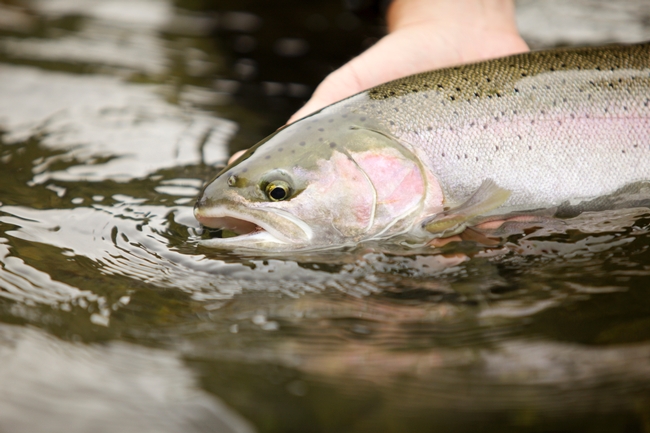Posts Tagged: salmon
Coho salmon endangered by drought
“It's grim. It's going to be a rough year for the coho,” said Mariska Obedzinski, a fish biologist who coordinates the coho monitoring program. “They can't get where they need to go.”
Obedzinski is part of the UC Sea Grant program, based at Scripps Institution of Oceanography in San Diego.
Two coho spawning streams — Porter and Pena creeks — are already cut off from the river. If no more rain falls, other tributaries, including Green Valley, Dutch Bill and Mill creeks, will likely go dry in spots, Obedzinski said.
The California Department of Fish and Wildlife is already planning rescue operations to save the smolts and younger fish in disconnected streams.
Last year some streams disconnections took place in late May, toward the end of the salmon run. The drying being seen in mid April may be unprecedented. Obedzinski said it was possibly the worst year for the fish since stream monitoring began in 2005.
A multiagency effort to save the Russian River coho began in 2001, when the fish were on the verge of extinction. The effort includes California Fish and Wildlife, National Marine Fisheries, U.S. Army Corps of Engineers and UC Sea Grant.
Conservation organization California Trout helps establish endowed chair at UC Davis
California once teemed with millions of native salmon, trout and steelhead. The state has 31 distinct types of these iconic, majestic fish. But decades of degradation to aquatic habitat has depleted their numbers in many areas of the state. According to a report by UC Davis fisheries professor Peter Moyle and colleagues, 20 of these fish species are in danger of extinction within the next century. They are important species not just for the recreational or commercial benefits they afford, but also because they are a direct reflection of the health of the environment.
“Large self-sustaining populations of native salmon and trout are found where streams are in reasonably good condition,” Moyle wrote in his 2008 report, “SOS: California's Native Fish Crisis.” This report was commissioned by the conservation organization California Trout (CalTrout), which exists to support conservation science, education, and advocacy efforts to protect California's water resources and fisheries.
Moyle, whose academic home is the Department of Wildlife, Fish and Conservation Biology at UC Davis, is no stranger to CalTrout. He is the foremost authority on California's native freshwater and anadromous (sea-run) fishes and has been a leader in research and conservation efforts. His research has provided the core science essential to statewide conservation planning for freshwater and estuarine native fishes, especially salmon and trout. Graduate students who studied with Moyle now occupy many top-level fish ecologist and management positions in state and federal agencies, as well as key nonprofits like CalTrout.
In May of this year CalTrout and UC Davis announced the formal creation of the Peter B. Moyle and California Trout Endowed Chair in Cold Water Fishes. The endowment will provide crucial support for the chair holder's scholarly activities, teaching, and public service involving cold water fish and aquatic ecosystems. He or she will teach department courses, mentor graduate students, conduct research and outreach, and provide leadership in the conservation of cold water fishes and their ecosystems. The university recognizes that salmon, trout, and steelhead are the major drivers of many conservation efforts and will have the highest priority in the chair's program.
Most of the contributors to the endowment are CalTrout board members such as Nick Graves. He and his wife, Mary, explored many trails and trout waters in the Sierra Nevada over the years and have enjoyed larger rivers flowing from the Trinity Alps, Mt. Shasta, and the Siskiyou Mountains. “The opportunity to create a scientific chair whose research targets California waters, in perpetuity, is a comforting thought,” Graves said.
“I have worked with the organization since its earliest days and have always admired the dedication of its members to aquatic conservation,” Moyle said. “I am biased, of course, but I think CalTrout has made a very smart investment in the future by creating an endowed chair.”
Flood protection, agriculture, fish and wildlife coexist in the Yolo Bypass
At times during the winter and early spring it looks like a vast inland sea between Sacramento and Davis. This is the Yolo Bypass, which shunts Sacramento River floodwater around the state capital during high flows. You drive over the bypass on a three-mile-long elevated stretch of Interstate 80 known as “the Causeway” (the Blecher-Freeman Memorial Causeway). The bypass is also the site of a lot of innovative fish and wildlife work.
From late fall through winter you can see thousands of ducks, geese and other waterfowl winging over the bypass’s flooded rice fields and the restored wetlands in the Vic Fazio Yolo Basin Wildlife Area.
The Central Valley of California is one of the nation’s most important migratory waterfowl corridors. The bypass provides essential winter habitat for these birds on their annual migration. The wildlife area is managed by the California Department of Fish and Wildlife. Learn more.A recent article in The Sacramento Bee featured a research project at a rice farming area in the upper reaches of the bypass that is examining how flooded fields could be used to fatten up young salmon during a crucial time in their life cycle. One part of the study is examining how soil type influences the production of insects — an important source of food for growing salmon. Carson Jeffres, a fish ecologist with the UC Davis Center for Watershed Sciences, is quoted in the story: "There are hundreds, if not thousands, of insects that are coming out of each 9-by-6-inch block of earth." You can also watch a YouTube video to hear UC Davis doctoral student Jacob Katz describe the project and read more about why fish find this floodplain so attractive in a previous Green Blog post by writer and photographer Trina Wood.
Part of the wildlife area is accessible by automobile — when it’s not flooded! Consider taking a tour of this remarkable and easily accessible area, or take binoculars to view the many birds. UC Davis fisheries professor Peter Moyle prepared a guide that will help you make the most of your visit.
Wine and fish for dinner? Water management required
The competition between farmers and fish for precious water in California is intensifying in wine country, say biologists at the University of California, Berkeley.
The researchers found that juvenile steelhead trout are particularly at risk during the dry summer season typical of California’s Mediterranean climate. Of the juvenile steelhead trout present in June, on average only 30 percent survived to the late summer. In years with higher rainfall and in watersheds with less vineyard land use, the survival of juvenile trout over the summer was significantly higher.
The researchers pointed out that salmon and trout conservation efforts have not adequately addressed summer stream flow. Previous studies have highlighted other limiting factors such as habitat degradation and water quality, while this study documented the importance of water quantity for restoring threatened populations.
Grantham says he is not suggesting we get rid of vineyards. “But we do need to focus our attention on water management strategies that reduce summer water use. I believe we can protect flows for fish and still have our glass of wine.”
Salmon suffering because of scant rain
Coho salmon are still in the Russian River's main stem rather than in the tributaries where they are usually spawning this time of year because of this winter's lack of rain, wrote Bob Norbert in the Press Democrat.
Biologists are concerned about any harm done to coho, a fish which is being coaxed back from the brink of extinction but still numbers only in the hundreds.
“There is so much invested in bringing these coho back, from the hatchery program to the restoration work in Dry Creek to the monitoring,” said Mariska Obedzinski, who is monitoring the coho recovery program for the UC Cooperative Extension. “For someone to go out and accidentally catch one when they are in the river, when they could kill or harm them, it is discouraging.”
Corps of Engineers leads coalition effort to save coho salmon
JC Delgadillo, www.army.mil, The U.S. Army
In the winter of 2011, biologists funded by the U.S. Army Corps of Engineers counted a record number of wild juvenile coho salmon in the downstream portions of the Russian River system in western Sonoma County. The project is conducted in collaboration with NOAA's National Marine Fisheries Service, experts at the University of California Cooperative Extension and the Sonoma County Water Agency.
"It's quite the group we have working together," said supervisory fisheries biologist Ben White of the U.S. Army Corps of Engineers. "You've got the best scientific knowledge in the region and people with a deep passion for coho recovery. You've got leaders among their peers working this issue, and I'm proud to be a part of it. You wouldn't be in this field if you didn't care about these fish, and everybody involved wants to see them recover."
Scientists release wasps to control citrus pest
Jeff Spurrier, L.A. at Home blog, Los Angeles Times
On Jan. 6, UC Riverside bio-control specialist Mark Hoddle released 300 tiny parasitic wasps from Pakistan in the L.A. County cities of Pico Rivera, Bell Gardens and South Gate to feed on the Asian citrus psyllid.
The article mentioned that curry leaf, an herb used in Indian cuisine, can be a host for the Asian citrus psyllid.
“If someone has curry leaf and are in the L.A. area, we’d be interested in looking at their plants and maybe using them for our parasite release,” Hoddle said.
The reality of extreme weather, Part 1
Lynne Friedmann, La Jolla Light
It’s not your imagination. Weather is becoming more “extreme,” leading to prolonged heat waves, heavier precipitation, severe flooding, more powerful hurricanes, and intense snowstorms.
Especially problematic is a trend toward long heat waves, during which morality increases, and more humid heat waves resulting in higher nighttime temperatures.
Evening “chill hours” in which the temperature drops below 450º F are also critical for agriculture.
“There are three million acres of fruit orchards with chilling requirements,” said Louise Jackson, UC Cooperative Extension plant physiology specialist. “Increasing humid heat also impacts red wine grape yields.”










